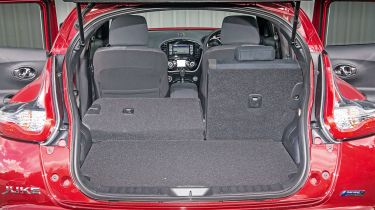Used Nissan Juke (Mk1, 2010-2019) review - How practical is it?
With an emphasis on style, the Juke isn’t as spacious and versatile as some of its newer compact crossover rivals
It would be unfair to say the Juke is all style and no substance, but you will have to make some compromises to run the eye-catching Nissan. In fairness, it’s fine in most situations, but if you’re looking for a small car to double as family transport, then you might have to give the cramped Juke a miss.
Dimensions and cabin design
The Juke looks deceptively tiny because its SUV proportions are more often the stuff of much larger cars. In fact, at 4,125mm it’s longer than a Ford Fiesta, and at 1,765mm and 1,570mm respectively, wider and quite a bit taller, too. Still, the high driving position makes front visibility excellent, and this is an easy car to place on the road. Rearward, though, the styling does leave large blind spots at the thick C-pillars.
The interior of the standard Nissan Juke, from the entry level Visia to range-topping Tekna, is more functional than upmarket. However, there are some bold design flourishes, such as the bulbous gear lever surround that’s designed to look like a motorbike’s fuel tank.
As a package the Juke is the opposite of, say, the Volkswagen Up because its sloping roof, high interior floor and chunky interior styling eat into space noticeably. The Juke simply doesn’t have much room and lags behind rivals like the Renault Captur and the Ford EcoSport.
Used - available now
In reality this makes the Juke the sort of car that’s best for those who don’t always need the back seats. This is not a five-seat car (despite having five three-point seatbelts) and headroom is restrictive for taller people. The thick-set front seats don’t help rear knee room, either, and also mean that rear-facing child seats placed in the back will force the front-seat occupants to move their seats forward to perhaps an uncomfortable position.
Boot space
The original Juke came with a paltry 251-litre boot, so in response to criticism Nissan improved it to a more usable 354 litres and included a twin floor, handy not only for easier loading but for concealing smaller valuables underneath the load cover.
The rear bench is 60:40 split-folding as standard and when fully folded liberates 1,189 litres of space. The problem with the shallow boot opening remains, but that’s a respectable amount of space. Again, though, it’s trumped by the Renault Captur’s 1,235-litre capacity.
Equipment and technology
More basic Visia and Acenta models come without a central touchscreen, making do with a cheap-looking stereo head unit and, in the case of the Visia, a four-speaker setup of poor sound quality and with no Bluetooth phone connectivity. That issue is resolved in the Acenta, which also comes with six speakers.
N-Connecta and above come with Nissan’s touchscreen infotainment and navigation system, which offers shortcut buttons, but suffers from a small display. DAB is standard with the system though, as is a USB port for phone charging, steering wheel mounted controls and a colour reversing camera to assist parking.
Equipment levels are fairly generous, even on entry-level Visia models. For instance, all cars get air-conditioning, electric windows and a trip computer as standard. Acenta models added to this haul with climate control and cruise control.
Sat-nav, a reversing camera, DAB radio and Nissan Connect, which features Google’s Send-To-Car technology (allowing drivers to send sat-nav destinations from their smartphone to their car) come as standard on N-Connecta models, while Tekna grade cars get leather seats and Nissan’s Safety Shield.
Perhaps feeling the heat from the growing number of more modern rivals, Nissan added two new limited-edition trims to the Juke range in April 2017 - Tekna Pulse and N-Connecta Style. Tekna Pulse includes an uprated six-speaker sound system and is limited to 1,500 units, while the N-Connecta Style includes interior and exterior personalisation packs as standard.
The Nismo RS version is even more striking than any of the standard models, because it gets an aggressive body kit, lowered suspension, big black alloys and Nissan’s sports division’s traditional red highlights, including in-your-face red door mirrors. There’s more than a hint of Nissan GT-R about it, and it was designed to clearly appeal to the so-called ‘PlayStation generation’.
The Nismo’s interior differs slightly from regular models too, as the hot Juke gets a splash of Nismo badging and lots of soft-touch Alcantara trimmings for the steering wheel and sports seats. It’s impressive, but it still can’t hide the Juke’s fundamental quality shortcomings.
Safety
Thanks to its five-star Euro NCAP rating, the Juke is also one of the safest cars around – and considering it was tested before the 2014 update added features like Safety Shield, that’s an encouragement. It scored an excellent 87 per cent for adult occupant protection and 81 per cent for child occupant protection.
Safety Shield, which is standard on Acenta and optional on N-Connecta, comprises lane-departure warning, blindspot warning, and a sensor that detects people or animals moving behind the car. Six airbags are standard across the range, including driver, passenger, side impact and curtain.











